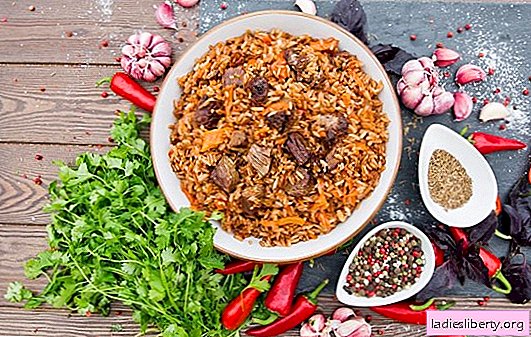
Fragrant and crumbly pilaf is not a dream, but a reality. The dish is easy to prepare in any kitchen with a gas stove. Yes, it’s on fire that it’s customary to cook pilaf. On an electric or induction hob, it will not work. But this is only one nuance that is often encountered. There are more serious errors.
Mistake One: Failure to Proportion
The main thing that needs to be learned during the preparation of pilaf is the proportion of products. Do not compare the dish with rice porridge with meat or Italian risotto. Here one carrot and a couple of onions can not do. Regardless of the selected recipe, meat or rice used, you should try to adhere to the recommended proportions. Then everything will work out for sure.
How many products to lay:
- For 1 kg of rice, not less than 0.8 kg of meat, ideally 1 kg. Moreover, if ribs are used, then the amount is recommended to be increased.
- For 1 kg of meat, not less than 0.5 kg of carrots, even better 0.8-1 kg. No need to throw "by eye". Raw chopped vegetable is quite voluminous, but after cooking it becomes much smaller.
- For 1 kg of meat is 0.3 kg of onions. It is important for pilaf to use only white and yellow varieties, the amount should not exceed.
Of course, you can add more onions, which perfectly fit into the pilaf, but he just can’t fry. For the same reason, the vegetable should be poured into hot fat, do not let it soften.
Second mistake: a saucepan, a frying pan, but not a cauldron
It’s better to completely abandon the idea of cooking pilaf, rather than doing it in a saucepan. Pans are also not good, especially a new type. Perhaps the house was littered with an old cast-iron frying pan with high sides. She's good. But here another question arises - is there a dense metal cover without holes for it. After all, in the pilaf it is important to retain all the moisture, the steam should return to the rice, and not go outside.
The ideal utensil is a cast-iron cauldron with thick walls and a heavy lid, which must be suitable in size. You can optionally wrap a cauldron with a wet rag. Or first dip a large clay dish into it, as is done in Asian countries, and then cover.
By the way, you can cook pilaf in a slow cooker. Subject to proportions, the dish will turn out, but only externally. Nevertheless, the “same” taste appears only in a cauldron and on fire.
Mistake Three: Save Fat
The pilaf is fat, oily, there are a lot of calories in the dish? It should be so! According to the rules, 1 or 2 kg of rice requires 250 or 300 g of oil. Here one or two spoons can not do. The taste, friability and aroma of pilaf depends on the amount of fat. It is in the oil that the vegetables with spices give off the aroma, and then all this goes into rice. It is not necessary to take one type of oil, you can mix it.
What fats to use:
- vegetable oil;
- lard or pork fat;
- beef fat;
- fat tail, mutton fat;
- chicken fat.
For best taste, mix vegetable and animal fats. If fat or kurdyuk is used, then they are cut and fried. It is very important to immediately lay and heat all the fat, regardless of its type. The first ingredients should be deep-fried. This is the only way vegetables will immediately fry. If there is little fat or it does not have time to warm up, then the products will begin to produce juice.
Fourth error: where is the zirvak?
Many housewives do not even know what a zirvak is. But it depends on it the taste and quality of pilaf. It’s not good to fry pieces of meat with carrots and onions. Zirvak is fried. And then stewed vegetables with meat in the broth. All this is stewed almost until ready with spices, only then rice is introduced to them.
How to cook zirvak:
- Heat fat. Or drown it from the fat, remove the greaves, add vegetable oil.
- Pour onion, fry until golden brown.
- Introduce the meat, continue to cook over high heat.
- After a few minutes, add the carrot, cook with it for a minute.
- Pour spices, pour water.
- Cover, simmer until meat is completely cooked.
It is important to measure the added water and not let the zirvak actively boil, boil. Otherwise, you can easily make a mistake with the amount of fluid.
Fifth mistake: oh, this pic
How many recommendations can be found regarding rice! What varieties are not recommended in recipes! You can sort it out for a long time and thoroughly, but the easiest way is to buy rice marked "for pilaf" in the store. Perhaps it will be a little more expensive than other round and long varieties, but it will definitely do. In no case do not take steamed rice, it will not give the desired taste.
How to prepare the rice:
- rinse with water, change it at least seven times;
- soak for a few minutes, you can add a spoonful of salt;
- rinse again, drain all water.
Rice is soaked not to speed cooking, but to release starch. If there is a lot of it left in the groats, you get a sticky and not crumbly pilaf. Salt is added so that when soaked, the rice retains its shape, does not crack.
Sixth error: a lot or a little water
One of the main ingredients in pilaf, as in any other cereal dish, is water. The consistency depends on it. In oriental recipes, mention of fingers is often found. Allegedly, boiling water is added two or three fingers above the rice. Such a measure is not always relevant, since a home cauldron can have absolutely any size and diameter of the bottom.
To cook ordinary friable rice add water 1: 2. But in pilaf this does not work.
The cereal is pre-soaked or thoroughly washed, in the process it absorbs water. The second point is a lot of juice in carrots and onions.
If you add 2 parts of water, you get porridge. If you pour a little, then the rice will not be able to cook.
It is believed that subject to the proportion of rice, carrots and oil 1: 1: 0.3, 1.2 liters of water is sufficient.
Seventh error: where are the spices?
Fragrant oriental pilaf is impossible to cook without spices. Be sure to add zira, paprika, different peppers, do not forget about the head of garlic and salt.
You can throw a bay leaf on top, but just do not deepen.
If you buy all seasonings separately expensively or simply there is no such possibility, then ready-made mixes marked "for pilaf" are suitable.
According to the rules, spices are added to zirvak. If you forgot to do this, then you can enter along with rice. Better late than never.











